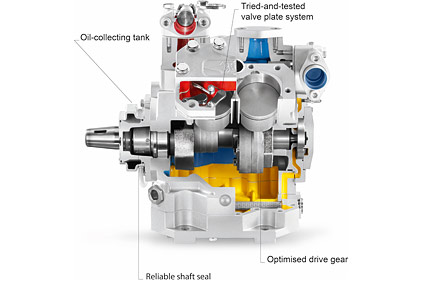
|
| This is a cutaway of a reciprocating compressor from Bitzer, which the company said has been optimized for use in bus air conditioning applications. |
Compressors
Mainstream Engineering Corp., Rockledge, Fla., has been awarded a contract from the Defense Advanced Research Projects Agency (DARPA) to develop a high-efficiency refrigeration compressor for compact thermal control and refrigeration applications.
“We are very excited to receive another contract to improve the performance of air conditioners and refrigeration systems, especially on the heels of our prior government-funded effort, which was so successful in improving the performance of residential heat pumps, and resulted in the QwikSEER+® product,” said Dr. Robert P. Scaringe, president of Mainstream.
The new DARPA contract will allow Mainstream to create additional engineering and production positions in Brevard County, Fla. “We currently have job openings in almost all engineering disciplines from bachelor’s degrees to doctorate,” said Scaringe. “Details of these jobs openings are provided on our website. This new DARPA contract award is one small step in a series of ongoing job-creating programs that are developing at Mainstream.”
Also regarding compressor developments Bitzer SE Group has reported that it has optimized its compressors for use in bus air conditioning applications and has begun manufacturing the ROADSTAR on four continents.
Its reciprocating compressors for transport are being made in the United States, Brazil, China, and Germany.
According to a press release issued by the company, “The strengthened drive gear and its innovative surface treatment increase the level of reliability and extend the service life of the compressor, even in demanding conditions. The integrated oil-collecting tank also simplifies maintenance and collection of the oil, which is isolated in very small amounts and required for lubrication and sealing as well as cooling the shaft seal.”
Leak Detection
A digital refrigerant leak detector (RLD400) from General Tools & Instruments has been certified by an accredited independent test laboratory to comply with the new ASHRAE Halocarbon Refrigerant Leak Detector Standard 173-2012. The instrument has been certified at a leak rate of less than 1 gram per year, the company said in a statement.
The standard was published by ASHRAE to establish a method of testing for qualifying the performance of portable leak detectors designed for the detection of all CFC, HCFC, HFC, HFO, and PFC halogenated refrigerant gases. The practices and procedures in this standard cover the testing of refrigerant leak detectors intended for use in the leak testing of refrigerating, air conditioning, and heat pump systems and their components, the manufacturer said.
General’s RLD400 is also certified to comply with SAE J2791, J2913, and J1627 standards, and the new European standard EN14624:2012.
With its proprietary semiconductor sensor, this instrument is built to detect all commercially available HFC, HFO, HC, HCFC and CFC refrigerant gases.
It can be used on mobile and stationary air conditioners, refrigerators, chillers, and heat pumps, as well as automotive and aviation a/c systems, the company said.
Absorption Refrigeration
A new blast freezer is using ammonia absorption at a seafood processing plant in Homer, Alaska.
According to the company, because of the high cost of electricity and oil, the plant was looking for a way to utilize more readily available and less costly coal. (It can also be powered with wood chips if necessary.) Coal is burned in a boiler that produces 320°F high pressure hot water to power the absorption refrigeration plant. Thirty-six tons of refrigeration is produced at -36°. The refrigeration is moved to CO2 at -30°and pumped to the blast chiller. In colder months, an air cooler is used. In warmer weather, seawater is used at 46°.
When there is no demand for blast freezing, the refrigeration is used to produce 10 tons of flake ice per day.
The ThermoChiller absorption refrigeration system is available in capacities from 10 to 200 tons. Besides the coal and wood chips, it can run on exhaust gas, natural gas, solar thermal heat, or geothermal heat, it was reported.
Publication date: 11/18/2013



Report Abusive Comment